生物素标记说明书
- 格式:pdf
- 大小:130.98 KB
- 文档页数:7
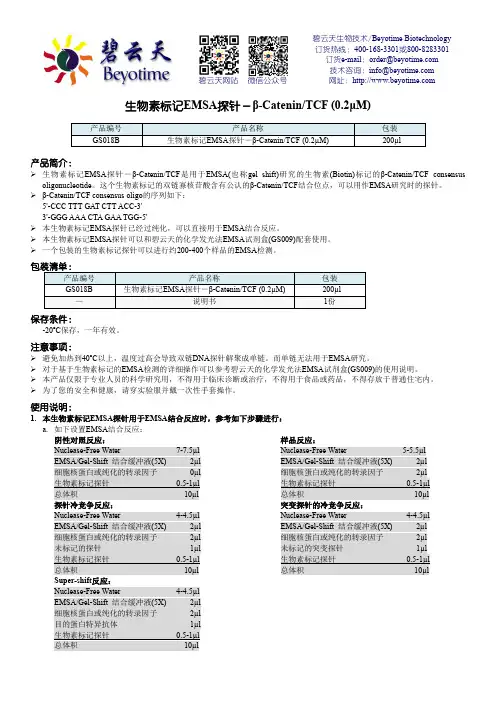
碧云天生物技术/Beyotime Biotechnology订货热线:400-168-3301或800-8283301订货e-mail:******************技术咨询:*****************网址:碧云天网站微信公众号生物素标记EMSA探针-β-Catenin/TCF (0.2μM)产品编号产品名称包装GS018B 生物素标记EMSA探针-β-Catenin/TCF (0.2µM) 200µl产品简介:生物素标记EMSA探针-β-Catenin/TCF是用于EMSA(也称gel shift)研究的生物素(Biotin)标记的β-Catenin/TCF consensus oligonucleotide。
这个生物素标记的双链寡核苷酸含有公认的β-Catenin/TCF结合位点,可以用作EMSA研究时的探针。
β-Catenin/TCF consensus oligo的序列如下:5'-CCC TTT GAT CTT ACC-3'3'-GGG AAA CTA GAA TGG-5'本生物素标记EMSA探针已经过纯化,可以直接用于EMSA结合反应。
本生物素标记EMSA探针可以和碧云天的化学发光法EMSA试剂盒(GS009)配套使用。
一个包装的生物素标记探针可以进行约200-400个样品的EMSA检测。
包装清单:产品编号产品名称包装GS018B 生物素标记EMSA探针-β-Catenin/TCF (0.2µM) 200µl—说明书1份保存条件:-20ºC保存,一年有效。
注意事项:避免加热到40ºC以上,温度过高会导致双链DNA探针解聚成单链。
而单链无法用于EMSA研究。
对于基于生物素标记的EMSA检测的详细操作可以参考碧云天的化学发光法EMSA试剂盒(GS009)的使用说明。
本产品仅限于专业人员的科学研究用,不得用于临床诊断或治疗,不得用于食品或药品,不得存放于普通住宅内。
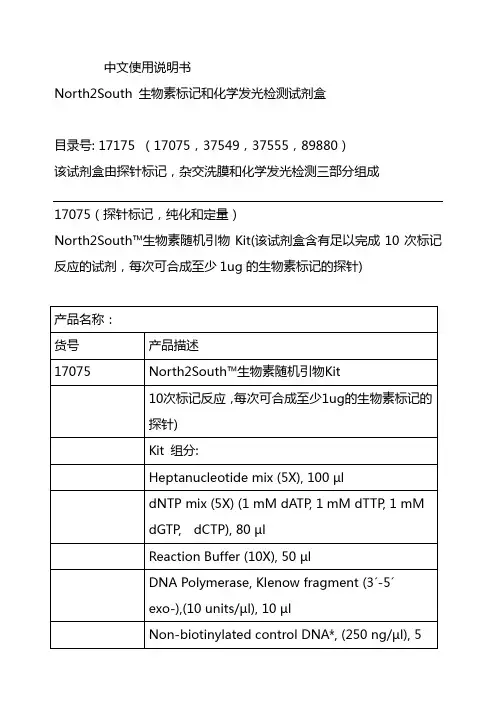
中文使用说明书North2South 生物素标记和化学发光检测试剂盒目录号: 17175 (17075,37549,37555,89880)该试剂盒由探针标记,杂交洗膜和化学发光检测三部分组成17075(探针标记,纯化和定量)North2South™生物素随机引物Kit(该试剂盒含有足以完成10次标记反应的试剂,每次可合成至少1ug的生物素标记的探针)储存条件:所有试剂应该在无霜冷冻-20°冰箱保存探针标记:操作步骤:将20ul生物素标记的N4-dCTP与80ul的5XdNTP混合物充分混合备用(总量100ul)1.稀释约100ng线性探针模板至24ul于离心管中(模板DNA要定量和纯化)2.加入10ul随机引物(Heptanucleotide mix)于上述离心管中,煮沸变性5分钟,迅速在冰水混合物退火5分钟3.加入10ul N4-dCTP与5XdNTP的混合物,5ul 反应缓冲液,1ul Klenow酶片断,混匀4.37°孵育60分钟5.加入2ul EDTA以灭活Klenow酶活性探针纯化操作步骤:1.加入5ulNH4OAC于上述50ul反应离心管,吹打混匀2.加入110 ul 冰预冷的无水乙醇,充分混匀,冰或-70°放置15分钟3.12000rpm 4°离心15分钟4.观察沉淀情况,小心吸取出上清,风干沉淀5.用冰预冷的70%乙醇洗涤一次,12000rpm 4°离心15分钟,观察沉淀情况,小心吸取出上清,风干沉淀6.50ulTE或RNA酶free 的水溶解沉淀(-20℃或-70℃长期保存)探针定量(17075)操作步骤:1.500ul去离子水,260nm调零2.充分混匀2.5ul 探针和47.5ul 去离子水(即稀释20倍)分光光度计测定OD260值3.定量计算公式:1 OD260 dsDNA = 50 μg/ml;样品浓度(μg/ml)=OD值X50X稀释倍数;样品浓度μg/ul= OD260值X50X20/1000样品浓度ng/ul= OD260值X50X20(注:如果稀释20倍,实际测定的OD260值应该在0.02-0.05之间)Note:大多数情况下,由于各实验室用来测定核酸的仪器不同,检测灵敏度不同以及样品中的一些干扰物质,测出的OD值往往是0甚至是负值,如果出现这种情况,再进行核酸定量没有实际价值,因此,根据经验,保守估计,在每次至少合成1ug探针的前提下,在杂交时,探针的用量按照每ul含有20ng探针来使用,即每毫升杂交液加入变性的纯化过的探针1.5-2ul.杂交和洗膜储存条件:4℃点杂交;样品转膜(带正电尼龙膜)使用前将所有试剂放到室温下,保证所有buffer 溶解充分,没有颗粒。
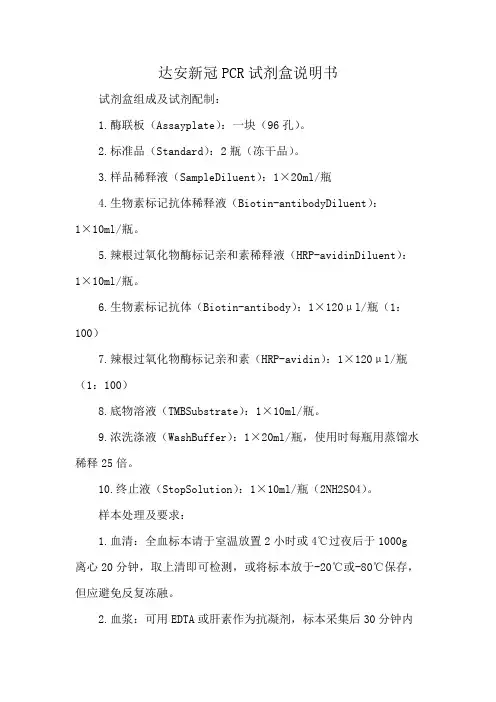
达安新冠PCR试剂盒说明书试剂盒组成及试剂配制:1.酶联板(Assayplate):一块(96孔)。
2.标准品(Standard):2瓶(冻干品)。
3.样品稀释液(SampleDiluent):1×20ml/瓶4.生物素标记抗体稀释液(Biotin-antibodyDiluent):1×10ml/瓶。
5.辣根过氧化物酶标记亲和素稀释液(HRP-avidinDiluent):1×10ml/瓶。
6.生物素标记抗体(Biotin-antibody):1×120μl/瓶(1:100)7.辣根过氧化物酶标记亲和素(HRP-avidin):1×120μl/瓶(1:100)8.底物溶液(TMBSubstrate):1×10ml/瓶。
9.浓洗涤液(WashBuffer):1×20ml/瓶,使用时每瓶用蒸馏水稀释25倍。
10.终止液(StopSolution):1×10ml/瓶(2NH2SO4)。
样本处理及要求:1.血清:全血标本请于室温放置2小时或4℃过夜后于1000g 离心20分钟,取上清即可检测,或将标本放于-20℃或-80℃保存,但应避免反复冻融。
2.血浆:可用EDTA或肝素作为抗凝剂,标本采集后30分钟内于2-8°C1000g离心20分钟,或将标本放于-20℃或-80℃保存,但应避免反复冻融。
3.组织匀浆:用预冷的PBS(0.01M,pH=7.4)冲洗组织,去除残留血液(匀浆中裂解的红细胞会影响测量结果),称重后将组织剪碎。
将剪碎的组织与对应体积的PBS(一般按1:9的重量体积比,比如1g的组织样品对应9mL的PBS,具体体积可根据实验需要适当调整,并做好记录。
推荐在PBS中加入蛋白酶抑制剂)加入玻璃匀浆器中,于冰上充分研磨。
为了进一步裂解组织细胞,可以对匀浆液进行超声破碎,或反复冻融。
将匀浆液于5000×g离心5~10分钟,取上清检测。
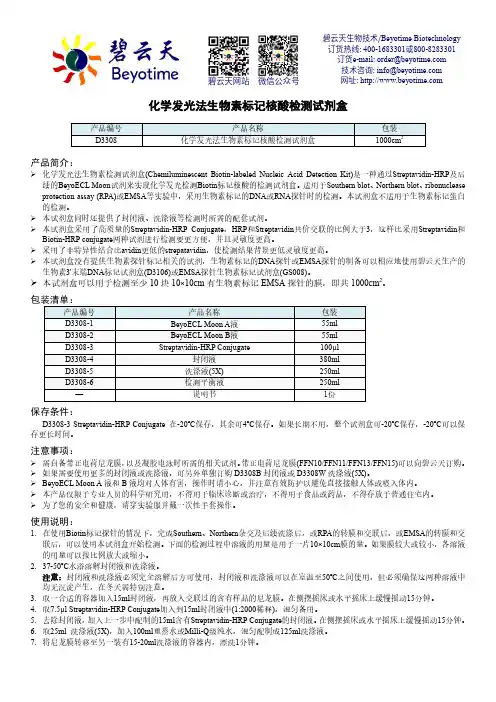
化学发光法生物素标记核酸检测试剂盒产品编号 产品名称包装 D3308化学发光法生物素标记核酸检测试剂盒1000cm 2产品简介:化学发光法生物素检测试剂盒(Chemiluminescent Biotin-labeled Nucleic Acid Detection Kit)是一种通过Streptavidin-HRP 及后续的BeyoECL Moon 试剂来实现化学发光检测Biotin 标记核酸的检测试剂盒。
适用于Southern blot 、Northern blot 、ribonuclease protection assay (RPA)或EMSA 等实验中,采用生物素标记的DNA 或RNA 探针时的检测。
本试剂盒不适用于生物素标记蛋白的检测。
本试剂盒同时还提供了封闭液、洗涤液等检测时所需的配套试剂。
本试剂盒采用了高质量的Streptavidin-HRP Conjugate ,HRP 和Streptavidin 共价交联的比例大于3,这样比采用Streptavidin 和Biotin-HRP conjugate 两种试剂进行检测要更方便,并且灵敏度更高。
采用了非特异性结合比avidin 更低的strepatavidin ,使检测结果背景更低灵敏度更高。
本试剂盒没有提供生物素探针标记相关的试剂,生物素标记的DNA 探针或EMSA 探针的制备可以相应地使用碧云天生产的生物素3'末端DNA 标记试剂盒(D3106)或EMSA 探针生物素标记试剂盒(GS008)。
本试剂盒可以用于检测至少10块10×10cm 有生物素标记EMSA 探针的膜,即共1000cm 2。
包装清单:产品编号 产品名称包装 D3308-1 BeyoECL Moon A 液 55ml D3308-2 BeyoECL Moon B 液 55ml D3308-3 Streptavidin-HRP Conjugate100µl D3308-4 封闭液 380ml D3308-5 洗涤液(5X)250ml D3308-6检测平衡液 250ml —说明书1份保存条件:D3308-3 Streptavidin-HRP Conjugate 在-20ºC 保存,其余可4ºC 保存。
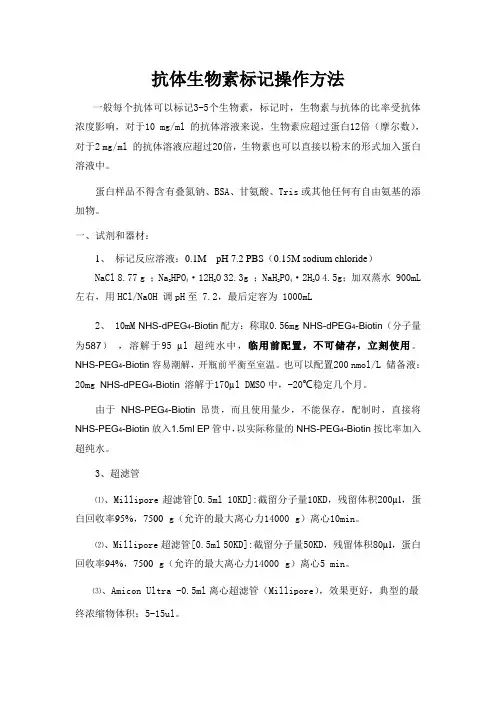
抗体生物素标记操作方法一般每个抗体可以标记3-5个生物素,标记时,生物素与抗体的比率受抗体浓度影响,对于10 mg/ml 的抗体溶液来说,生物素应超过蛋白12倍(摩尔数),对于2 mg/ml 的抗体溶液应超过20倍,生物素也可以直接以粉末的形式加入蛋白溶液中。
蛋白样品不得含有叠氮钠、BSA、甘氨酸、Tris或其他任何有自由氨基的添加物。
一、试剂和器材:1、标记反应溶液:0.1M pH 7.2 PBS(0.15M sodium chloride)NaCl 8.77 g ;Na2HPO4·12H2O 32.3g ;NaH2PO4·2H2O 4.5g;加双蒸水 900mL左右,用HCl/NaOH 调pH至 7.2,最后定容为 1000mL2、 10mM NHS-dPEG4-Biotin配方:称取0.56mg NHS-dPEG4-Biotin(分子量为587),溶解于95 µl 超纯水中,临用前配置,不可储存,立刻使用。
NHS-PEG4-Biotin容易潮解,开瓶前平衡至室温。
也可以配置200 nmol/L 储备液:20mg NHS-dPEG4-Biotin溶解于170µl DMSO中,-20℃稳定几个月。
由于NHS-PEG4-Biotin昂贵,而且使用量少,不能保存,配制时,直接将NHS-PEG4-Biotin放入1.5ml EP管中,以实际称量的NHS-PEG4-Biotin按比率加入超纯水。
3、超滤管⑴、Millipore超滤管[0.5ml 10KD]:截留分子量10KD,残留体积200µl,蛋白回收率95%,7500×g(允许的最大离心力14000×g)离心10min。
⑵、Millipore超滤管[0.5ml 50KD]:截留分子量50KD,残留体积80µl,蛋白回收率94%,7500×g(允许的最大离心力14000×g)离心5 min。
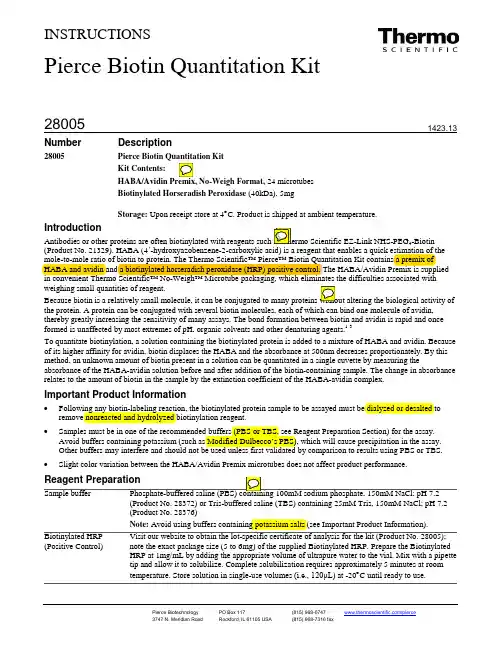
INSTRUCTIONSNumberDescription28005 Kit Contents:24 microtubesBiotinylated Horseradish Peroxidase(40kDa), 5mgStorage: Upon receipt store at 4°C. Product is shipped at ambient temperature.Introduction4-Biotin (Product No. 21329). HABA (4´-hydroxyazobenzene-2-carboxylic acid) is a reagent that enables a quick estimation of the mole-to-mole ratio of biotin to protein. The Thermo Scientific™ Pierce™ Biotin Quantitation Kit contains a premix of HABA and avidin and a biotinylated horseradish peroxidase (HRP) positive control. The HABA/Avidin Premix is supplied in convenient Thermo Scientific™ No-Weigh™ Microtube packaging, which eliminates the difficulties associated with weighing small quantities of reagent.the protein. A protein can be conjugated with several biotin molecules, each of which can bind one molecule of avidin, thereby greatly increasing the sensitivity of many assays. The bond formation between biotin and avidin is rapid and once formed is unaffected by most extremes of pH, organic solvents and other denaturing agents.1-3To quantitate biotinylation, a solution containing the biotinylated protein is added to a mixture of HABA and avidin. Because of its higher affinity for avidin, biotin displaces the HABA and the absorbance at 500nm decreases proportionately. By this method, an unknown amount of biotin present in a solution can be quantitated in a single cuvette by measuring theabsorbance of the HABA-avidin solution before and after addition of the biotin-containing sample. The change in absorbance relates to the amount of biotin in the sample by the extinction coefficient of the HABA-avidin complex.Important Product Information• Following any biotin-labeling reaction, the biotinylated protein sample to be assayed must be dialyzed or desalted to remove nonreacted and hydrolyzed biotinylation reagent.•Samples must be in one of the recommended buffers (PBS or TBS, see Reagent Preparation Section) for the assay. Avoid buffers containing potassium (such as Modified Dulbecco’s PBS), which will cause precipitation in the assay. Other buffers may interfere and should not be used unless first validated by comparison to results using PBS or TBS. •Slight color variation between the HABA/Avidin Premix microtubes does not affect product performance.(Product No. 28376)Note: Avoid using buffers containing potassium salts (see Important Product Information).Biotinylated HRP (Positive Control)Visit our website to obtain the lot-specific certificate of analysis for the kit (Product No. 28005); note the exact package size (5 to 6mg) of the supplied Biotinylated HRP. Prepare the Biotinylated HRP at 1mg/mL by adding the appropriate volume of ultrapure water to the vial. Mix with a pipette tip and allow it to solubilize. Complete solubilization requires approximately 5 minutes at room temperature. Store solution in single-use volumes (i.e., 120μL ) at -20°C until ready to use.Pierce Biotin Quantitation KitProcedure for Quantitation of Moles of Biotin per Mole of Protein – Cuvette Format Note: The Biotinylated HRP may be used as a positive control to verify assay performance. See the product label for the biotinylation level.1.Equilibrate the HABA/Avidin Premix to room temperature.2.Add 100μL of ultrapure water to one microtube of the HABA/Avidin Premix. Mix with pipette tip.3.Pipette 800μL of PBS or other sample buffer into a 1mL cuvette. Use this cuvette with PBS to zero thespectrophotometer.4.Add the 100μL of the HABA/Avidin Premix solution from step 2 to the cuvette. Mix by inversion.5.Measure the absorbance of the solution in the cuvette at 500nm and record the value as A500 HABA/avidin.6.Add 100μL of biotinylated protein sample or biotinylated HRP (positive control) to the cuvette containing HABA/avidinand mix well.7.Measure the absorbance of the solution in the cuvette at 500nm and record the value as A500 HABA/avidin/biotin sampleonce the value remains constant for at least 15 seconds. If the A500 HABA/avidin/biotin sample is ≤ 0.3, dilute the sample and repeat the assay.Note: Dilutions must be accounted in the calculation step.8.Proceed to the Calculation of Moles of Biotin per Mole of Protein section.Procedure for Quantitation of Moles of Biotin per Mole of Protein – Microplate Format Note: The Biotinylated HRP may be used as a positive control to verify assay performance. See the product label for the biotinylation level.1.Equilibrate the HABA/Avidin Premix to room temperature.2.Add 100μL of ultrapure water to one microtube of the HABA/Avidin Premix. Mix with pipette tip.3.Pipette 160μL of PBS into a microplate well.4.Add 20μL of the HABA/Avidin Premix solution from step 2 to the PBS in the well. Place microplate on an orbital shakeror equivalent to mix.5.Measure the absorbance of the solution in the well at 500nm and record the value as A500 HABA/avidin.6.Add 20μL of biotinylated sample or Biotinylated HRP (positive control) to the well containing the HABA/avidinreaction mixture. Mix as described above.7.Measure the absorbance of the solution in the well at 500nm and record the value as A500 HABA/avidin/biotin sampleonce the value remains constant for at least 15 seconds.8.Proceed to the Calculation of Moles of Biotin per Mole of Protein section.Calculation of Moles of Biotin per Mole of ProteinNote: The HABA Calculator, which is available from the Technical Resources menu from our website, will calculate the moles of biotin/mole of protein upon entering the required values.These calculations are based on the Beer Lambert Law (Beer’s Law): Aλ = ελ bCWhere:A is the absorbance of the sample at a particular wavelength (λ). The wavelength for the HABA assay is 500nm.There are no units for absorbance.εis the absorptivity or extinction coefficient at the wavelength (λ). For HABA/avidin samples at 500nm, pH 7.0extinction coefficient is equal to 34,000 M-1cm-1.b is the cell path length expressed in centimeters (cm). A 10mm square cuvette has a path length of 1.0cm. Using therecommended microplate format volumes, the path length is typically 0.5cm.C is the concentration of the sample expressed in molarity (= mol/L = mmol/mL).The values needed for calculating the number of moles of biotin per mole of protein or sample are as follows: • Concentration of the protein or sample used, expressed as mg/mL• Molecular weight (MW) of the protein, expressed as grams per mole (e.g., HRP = 40,000; IgG =150,000) • Absorbance at 500nm for HABA/avidin reaction mixture (A 500 H\A )• Absorbance at 500nm for HABA/avidin/biotin reaction mixture (A 500 H\A\B )•Dilution factor, if the sample is diluted before adding to the HABA/avidin reaction mixture1. Calculation #1 is for the concentration of biotinylated protein in mmol/mL (before any dilution for the assay procedure):1#(mg/mmol)protein of MW (mg/mL)ion concentrat protein mL per protein mmol Calc ==2. Calculation #2 is for the change in absorbance at 500nm:• Cuvette:∆A 500 = (0.9 × A 500 H\A) – (A 500 H\A\B) = Calc #2 • Microplate:∆A 500 = (A 500 H\A) – (A 500 H\A\B) = Calc #23. Calculation #3 is for the concentration of biotin in mmol permL of reaction mixture:3#)(34,0002#)(34,000ΔA mixture reaction ml biotin mmol 500Calc b Calc b =×=×=4. Calculation #4 is for the mmol of biotin per mmol of protein:sampleoriginal in protein mmol sampleoriginal in biotin mmol =sample original in protein ml per mmol factor)(dilution )10mixture)(reaction in biotin ml per (mmol =1factordilution 10)3#(Calc#Calc ××=TroubleshootingAdditional InformationA.Optional Pronase DigestionNote: Pronase can be used to digest the protein to expose biotin groups that may be buried within the molecule and sterically hindered from binding to avidin. This Pronase method is optional and is not normally necessary because for most applications it is sufficient to quantify the number of biotin groups available on the surface of the protein molecule.1.Prepare 1% Pronase (w/v) in ultrapure water.2.Heat 100µL of biotinylated protein sample at 56°C for 10 minutes.3.Add 10µL of 1% pronase to the sample and digest overnight at room temperature.4.Quantitate biotinylation as previously described.B.Please visit our website for additional information on this product including the following:•Use the HABA Calculator to determine the moles of biotin/mole of protein in your sample. Enter the absorbance values, protein molecular weight and protein concentration and the biotin/protein molar ratio will be calculated for you. The HABA Calculator can be accessed from the Technical Resources menu.Related Thermo Scientific Products21329 EZ-Link NHS-PEG4-Biotin, No-Weigh Format, 8 × 2mg21329 EZ-Link NHS-PEG4-Biotin, 25mg21331 EZ-Link Sulfo-NHS-SS-Biotin, 100mg21334 EZ-Link Iodoacetyl-PEG2-Biotin, 50mg21901 EZ-Link Maleimide-PEG2-Biotin, 50mg29139 Biotinylated Horseradish Peroxidase, 5mgReferences1.Green, N.M. (1975). Avidin. In Adv. in Protein Chemistry. Academic Press, New York. 29:85-133.2.Green, N.M., et al. (1971). The use of bifunctional biotinyl compounds to determine the arrangement of subunits in avidin. Biochem. J. 125:781-91.3.Green, N.M. (1965). A spectrophotometric assay for avidin and biotin based on binding of dyes by avidin. Biochem. J. 94:23c-24c.Products are warranted to operate or perform substantially in conformance with published Product specifications in effect at the time of sale, as set forth in the Product documentation, specifications and/or accompanying package inserts (“Documentation”). No claim of suitability for use in applications regulated by FDA is made. The warranty provided herein is valid only when used by properly trained individuals. Unless otherwise stated in the Documentation, this warranty is limited to one year from date of shipment when the Product is subjected to normal, proper and intended usage. This warranty does not extend to anyone other than Buyer. Any model or sample furnished to Buyer is merely illustrative of the general type and quality of goods and does not represent that any Product will conform to such model or sample.NO OTHER WARRANTIES, EXPRESS OR IMPLIED, ARE GRANTED, INCLUDING WITHOUT LIMITATION, IMPLIED WARRANTIES OF MERCHANTABILITY, FITNESS FOR ANY PARTICULAR PURPOSE, OR NON INFRINGEMENT. BUYER’S EXCLUSIVE REMEDY FOR NON-CONFORMING PRODUCTS DURING THE WARRANTY PERIOD IS LIMITED TO REPAIR, REPLACEMENT OF OR REFUND FOR THE NON-CONFORMING PRODUCT(S) AT SELLER’S SOLE OPTION. THERE IS NO OBLIGATION TO REPAIR, REPLACE OR REFUND FOR PRODUCTS AS THE RESULT OF (I) ACCIDENT, DISASTER OR EVENT OF FORCE MAJEURE, (II) MISUSE, FAULT OR NEGLIGENCE OF OR BY BUYER, (III) USE OF THE PRODUCTS IN A MANNER FOR WHICH THEY WERE NOT DESIGNED, OR (IV) IMPROPER STORAGE AND HANDLING OF THE PRODUCTS.Unless otherwise expressly stated on the Product or in the documentation accompanying the Product, the Product is intended for research only and is not to be used for any other purpose, including without limitation, unauthorized commercial uses, in vitro diagnostic uses, ex vivo or in vivo therapeutic uses, or any type of consumption by or application to humans or animals.Current product instructions are available at /pierce. For a faxed copy, call 800-874-3723 or contact your local distributor.© 2014 Thermo Fisher Scientific Inc. All rights reserved. Pronase is a trademark of Calbiochem. Unless otherwise indicated, all other trademarks are property of Thermo Fisher Scientific Inc. and its subsidiaries. Printed in the USA.。
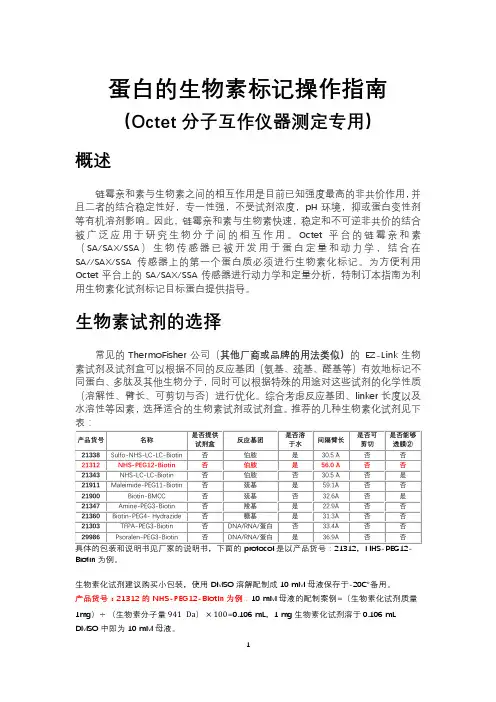
蛋白的生物素标记操作指南(Octet分子互作仪器测定专用)概述链霉亲和素与生物素之间的相互作用是目前已知强度最高的非共价作用,并且二者的结合稳定性好,专一性强,不受试剂浓度,pH环境,抑或蛋白变性剂等有机溶剂影响。
因此,链霉亲和素与生物素快速,稳定和不可逆非共价的结合被广泛应用于研究生物分子间的相互作用。
Octet平台的链霉亲和素(SA/SAX/SSA)生物传感器已被开发用于蛋白定量和动力学,结合在SA//SAX/SSA传感器上的第一个蛋白质必须进行生物素化标记。
为方便利用Octet平台上的SA/SAX/SSA传感器进行动力学和定量分析,特制订本指南为利用生物素化试剂标记目标蛋白提供指导。
生物素试剂的选择Biotin为例。
生物素化试剂建议购买小包装,使用DMSO溶解配制成10 mM母液保存于-20℃备用。
产品货号:21312的NHS-PEG12-Biotin为例:10 mM母液的配制案例=(生物素化试剂质量1mg)÷(生物素分子量941 Da)×100=0.106 mL,1 mg生物素化试剂溶于0.106 mL DMSO中即为10 mM母液。
氨基偶联生物素化试剂反应示意图实验试剂和耗材1)缓冲液:DMSO,1×PBS,PBST(PBS+0.02% tween20)2)掌上离心机,一台3)生物素标记试剂EZ-Link NHS-PEG12-Biotin (Thermo,货号:21312) 1 mg,加入0.106 mL的DMSO配置成10 mM母液4)PD Min iTrap™ G-25 Desalting Column用于脱盐,蛋白样品体积0.1-0.5 mL,(GE, 货号:28-9180-07 )。
5)Zeba desalting spin columns脱盐柱:a)蛋白样品体积30-130 uL,使用0.5 mL脱盐柱(Thermo, 货号:89882)b)蛋白样品体积200-700 uL,使用2 mL脱盐柱(Thermo, 货号:89889)c)蛋白样品体积600-2000 uL,使用5 mL脱盐柱(Thermo, 货号:89891)6)透析装置:Slide-A-Lyzer™ Dialysis Cassettes(Thermo,具体型号根据目标蛋白样品体积以及目标蛋白的分子量进行选择。
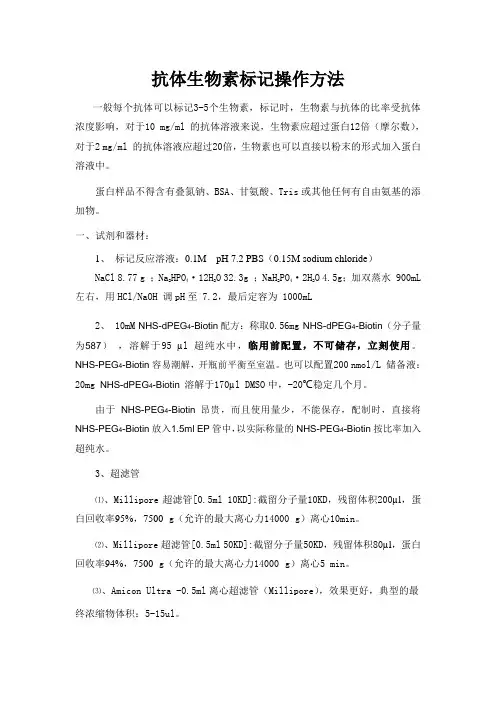
抗体生物素标记操作方法一般每个抗体可以标记3-5个生物素,标记时,生物素与抗体的比率受抗体浓度影响,对于10 mg/ml 的抗体溶液来说,生物素应超过蛋白12倍(摩尔数),对于2 mg/ml 的抗体溶液应超过20倍,生物素也可以直接以粉末的形式加入蛋白溶液中。
蛋白样品不得含有叠氮钠、BSA、甘氨酸、Tris或其他任何有自由氨基的添加物。
一、试剂和器材:1、标记反应溶液:0.1M pH 7.2 PBS(0.15M sodium chloride)NaCl 8.77 g ;Na2HPO4·12H2O 32.3g ;NaH2PO4·2H2O 4.5g;加双蒸水 900mL左右,用HCl/NaOH 调pH至 7.2,最后定容为 1000mL2、 10mM NHS-dPEG4-Biotin配方:称取0.56mg NHS-dPEG4-Biotin(分子量为587),溶解于95 µl 超纯水中,临用前配置,不可储存,立刻使用。
NHS-PEG4-Biotin容易潮解,开瓶前平衡至室温。
也可以配置200 nmol/L 储备液:20mg NHS-dPEG4-Biotin溶解于170µl DMSO中,-20℃稳定几个月。
由于NHS-PEG4-Biotin昂贵,而且使用量少,不能保存,配制时,直接将NHS-PEG4-Biotin放入1.5ml EP管中,以实际称量的NHS-PEG4-Biotin按比率加入超纯水。
3、超滤管⑴、Millipore超滤管[0.5ml 10KD]:截留分子量10KD,残留体积200µl,蛋白回收率95%,7500×g(允许的最大离心力14000×g)离心10min。
⑵、Millipore超滤管[0.5ml 50KD]:截留分子量50KD,残留体积80µl,蛋白回收率94%,7500×g(允许的最大离心力14000×g)离心5 min。
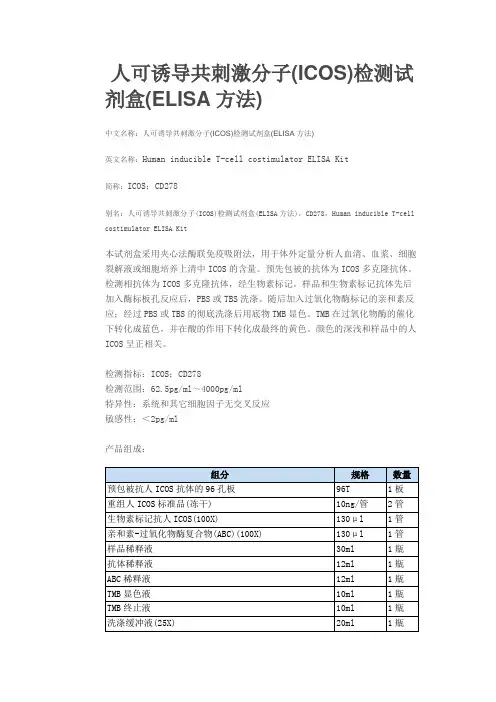
人可诱导共刺激分子(ICOS)检测试剂盒(ELISA方法)
中文名称:人可诱导共刺激分子(ICOS)检测试剂盒(ELISA方法)
英文名称:Human inducible T-cell costimulator ELISA Kit
简称:ICOS;CD278
别名:人可诱导共刺激分子(ICOS)检测试剂盒(ELISA方法),CD278,Human inducible T-cell costimulator ELISA Kit
本试剂盒采用夹心法酶联免疫吸附法,用于体外定量分析人血清、血浆、细胞裂解液或细胞培养上清中ICOS的含量。
预先包被的抗体为ICOS多克隆抗体。
检测相抗体为ICOS多克隆抗体,经生物素标记。
样品和生物素标记抗体先后加入酶标板孔反应后,PBS或TBS洗涤。
随后加入过氧化物酶标记的亲和素反应;经过PBS或TBS的彻底洗涤后用底物TMB显色。
TMB在过氧化物酶的催化下转化成蓝色,并在酸的作用下转化成最终的黄色。
颜色的深浅和样品中的人ICOS呈正相关。
检测指标:ICOS;CD278
检测范围:62.5pg/ml~4000pg/ml
特异性:系统和其它细胞因子无交叉反应
敏感性:<2pg/ml
产品组成:
储存条件:2-8℃(频繁使用时),-20℃(长时间不用时)。
有效期:6个月(4℃);12个月(-20℃)。
参考标准曲线数据:(取自某一批次质检数据,仅供参考,用户需要自己建立标准曲线)。
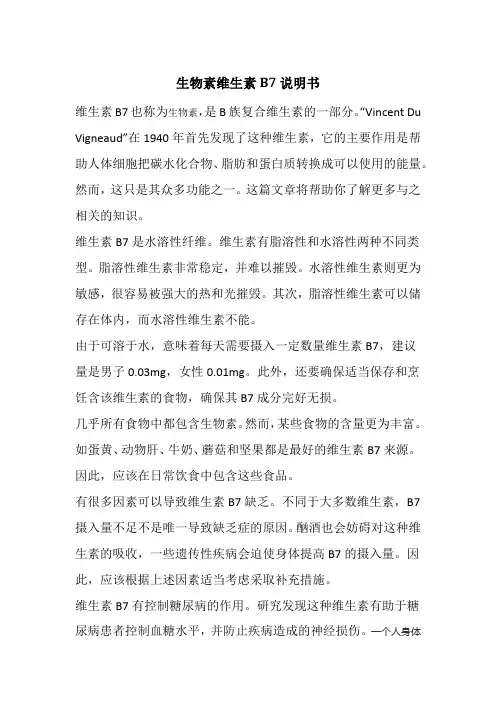
生物素维生素B7说明书维生素B7也称为生物素,是B族复合维生素的一部分。
“Vincent Du Vigneaud”在1940年首先发现了这种维生素,它的主要作用是帮助人体细胞把碳水化合物、脂肪和蛋白质转换成可以使用的能量。
然而,这只是其众多功能之一。
这篇文章将帮助你了解更多与之相关的知识。
维生素B7是水溶性纤维。
维生素有脂溶性和水溶性两种不同类型。
脂溶性维生素非常稳定,并难以摧毁。
水溶性维生素则更为敏感,很容易被强大的热和光摧毁。
其次,脂溶性维生素可以储存在体内,而水溶性维生素不能。
由于可溶于水,意味着每天需要摄入一定数量维生素B7,建议量是男子0.03mg,女性0.01mg。
此外,还要确保适当保存和烹饪含该维生素的食物,确保其B7成分完好无损。
几乎所有食物中都包含生物素。
然而,某些食物的含量更为丰富。
如蛋黄、动物肝、牛奶、蘑菇和坚果都是最好的维生素B7来源。
因此,应该在日常饮食中包含这些食品。
有很多因素可以导致维生素B7缺乏。
不同于大多数维生素,B7摄入量不足不是唯一导致缺乏症的原因。
酗酒也会妨碍对这种维生素的吸收,一些遗传性疾病会迫使身体提高B7的摄入量。
因此,应该根据上述因素适当考虑采取补充措施。
维生素B7有控制糖尿病的作用。
研究发现这种维生素有助于糖尿病患者控制血糖水平,并防止疾病造成的神经损伤。
一个人身体正常机能的发挥是需要用各种营养成分支撑的,维生素b7 就是其中的一种,这种维生素主要发挥的作用体现在对于皮肤黏膜和免疫系统当中的,由于其细胞内部含有一定的感光物质,所以在使用的时候需要适度的避开阳光的直射,还应该注意保护眼角膜等比较脆弱的器官在日常当中维生素b7是比较少听说的,维生素b7被称作为生物素,是生物体固定二氧化碳的重要因素。
缺乏;缺乏维生素b7会导致脱毛、皮炎或者是体重降低。
注意;大量的食用鸡蛋白会阻碍生物素的吸收。

生物素标记试剂盒使用说明书货号: EBLK0002产品介绍:Elabscience生物素标记试剂盒提供了生物素标记所需全部试剂,用于含有氨基(NH2-)抗体的标记。
生物素已经活化,可直接使用,每个试剂盒足以完成3次标记,每次可标记0.2-2mg。
试剂盒中包括6个用于抗体标记脱盐的Filtration tube,不用透析,操作简便,熟练操作90min可完成整个标记过程。
产品特点:试剂全面:本试剂盒提供了生物素标记所需全部试剂。
快速:整个过程仅需90min。
方便:通过Filtration tube即可脱盐,无需透析或者凝胶过滤。
使用灵活:既可用于微量标记又可大量标记,每次可标记0.2-2mg。
理想的标记效果:已经优化确定了最适的标记比例,降低标记不足或由于过度标记而失活的可能性。
产品组成:标记过程需要仪器:1. 10ul,50ul,200ul,1000ul可调高精度移液器2. 恒温箱(37℃)3. 离心机(离心力可达到12,000×g)储存条件:本试剂盒未开封前在2-8℃可稳定保存一年生物素标记反应原理:NH2-Reactive Biotin专一地与伯胺反应(N-末端及赖氨酸残基侧链)形成稳定的酰胺键生物素标记NH2-Reactive Biotin使用量的计算:每个反应中生物素试剂的使用量取决于待标记蛋白质的量和浓度。
通过优化,我们确定了标记2mg/ml的抗体(IgG ,150KD),使用生物素和抗体的分子比为20:1能达到较理想的标记效果。
1、标记2mg/ml的抗体,使用生物素和抗体的分子比为20:1时,应加入生物素量的计算方法:ml蛋白×2mg蛋白ml蛋白×1mmolIgG150,000mgIgG×20mmol生物素mmol蛋白= mmol生物素2、对于10mmol的生物素溶液,应加入反应中该生物素体积的计算方法:mmol生物素×1,000,000μLL ×L10mmol= ul生物素计算示例:对于0.5ml 2mg/ml的IgG(分子量为150,000)溶液,需加入10mM的生物素溶液13.3ul。
1 煮透析袋,纯水,1L烧杯,加0.1-1.0%EDTA,待水沸腾,将透析袋扔进去,20分钟。
2 配制NAHCO3~NA2CO
3 缓冲液
NAHCO3:2.93g
NA2CO3:1.59g 溶于1000ml双蒸水,PH大约9.6 浓度0.01 mol/L 3 待标记的Ab移入透析袋中,用0.01 mol/L ,PH大于8.7的碳酸盐缓冲液透析过夜,移入2ml EP管中。
4 称1mg Biotin 溶于1ml DMSO中。
5 取50ul Biotin 溶液加至1 mg /L。
Ab中(浓度至少为1 mg /mL,否则难以标记)Biotin在标记液中约1/15M。
6 将EP管放入震荡器,室温,避光震荡4h.
7 纯化:
透析:用0.01mol PH 7.2 的PB溶液透析72 h,弃除游离Biotin,每天换液2次,约8到12 h换一次。
PB母液配制:0.2 mol/L,PH大约7.3
NA2HPO4.12 H2O:35.8g加入500 ml双蒸水
NAH2PO4.2H2O:15.6g 加入500 ml双蒸水
配制时,取1 81ml NA2HPO4,0.2 mol/L溶液,2 19ml NAH2PO4 0.2 mol/L溶液。
一共100ml,
8 已标记的Biotin-Ab用7.2PH PBS 保存,经浓度0.15单位的NACL 缓冲液稀释至2倍工作浓度,分装于4度保存。
注意:1 标记前注意抗体效价
2 标记后检测。
生物素标记生物素标记1,向皿中加入2ml 1mg/ml的生物素试剂。
2,4℃,温和shaking30min,孵育后有一些细胞会悬浮起来,转移这些细胞至离心管中,离心收集细胞,并按下面方法洗涤细胞。
3,用2ml含0.1mM Ca+,1mM mg2+,100Mm Glycine的PBS清洗细胞2次,这时也会有一些细胞悬浮起来,转移它们到一个离心管,离心收集细胞。
4,加2ml含0.1mM Ca+,1mM mg2+的PBS到皿中。
5,4℃,45min停止未反应的生物素试剂的反应。
(使生物素试剂失活),并收集浮起来的细胞,离心收集细胞。
6,收集细胞:将皿中的细胞和浮起来的细胞转移进入一个1.5ml 的离心管。
7,向1.5ml的离心管中加入1ml RIPA/lysis buffer。
(含蛋白酶抑制剂1table /50ml)8,4℃涡旋1h。
9,20000g,10min,4℃,以沉淀核酸与其他残渣。
10,把上清转入新的EP管,(这是总蛋白,T,一般情况下浓度应该在1-5mg/ml,可以用B radford method来测定浓度,并调整全部样品至同一浓度)11,向300ul pre-cleared sample中加入300ul含50% slurry-Avidin beads的PBS,P I孵育。
(PI,蛋白酶抑制剂,的工作浓度0.1-1mM,17-174ug/ml)12,室温涡旋1h。
(使生物素和亲和素充分结合)13,离心除去beads,将上清转移至一新离心管中。
(这是位结合的蛋白质,浓度相对于总蛋白被稀释了1.5倍。
)14,向beads中加入150ul 2×Laemmli buffer来将beads上的蛋白质洗掉。
(洗下来的蛋白浓度是总蛋白浓度的2倍)。
生物素标记抗体生物素标记反应简单、温和且很少抑制抗体活性,生物素标记的抗体可存放多年而不失活。
能与生物素结合的二级试剂素,所需的各种标记物均可购置。
此外,亲和素和链霉亲和素的结合背景水平非常低.结合紧密且快速。
故可消除多步骤程序中的许多缺点。
生物素拯记—尥王要优点是标记一抗后,再选用亲和素或链霉亲和素标记的二级试剂素进行测定。
抗体很容易与经过化学修饰的活化生物素结合。
生物素又可以与结合有酶、荧光染料的亲和素或链霉亲和素连接,后者已有商品试剂供应。
这样只需将纯化抗体与生物素结合,就可用各种不同的标记物来检测。
链霉亲和素及亲和素与生物素的亲和力非常高(Ka1015L/mo1),并且二者间的相互作用实质上是不可逆的。
由于链霉亲和素的等电点(pI)更适宜故其更常用,背量也因此较低。
将生物素与抗体共价结合是一种非常简便和直接的标记方法。
通常,生物素对抗体并无负面影响且标记条件温和,用亲和素或链霉亲和素标记试剂进行检测的敏感性与使用标记抗IZ抗体相同。
Becker和Wichek(1972)、Heitzmann和Richards(1974)及Heggeness和Ash(1977)等提供了首次使用生物素与亲和素复合物的例证,而且Green(1963,1990)对两者的相互作用做了详细论述。
大多数生物素酰基化反应是利用生物素的N—羟基琥珀酰亚胺酯。
琥珀酰亚胺基可以与抗体上的自由氨基结合,通常是赖氨酰侧链。
现在许多生物素酰基化酯均可购得。
此类变构物改变了生物素的分子大小及其与偶合基团之间空间桥联臂的特性等。
某些情况下,空间桥联臂起决定性作用。
例如,较长的空间桥联臂可以使偶联物更容易接近生物素,其柔韧性也更好,尽管也更容易出现非特异结合。
某些空间桥联臂可以劈开,这样就可在一定的控制条件下将抗体释放出来。
表4.6列出许多可以利用的空间桥联臂及其特性。
所有这些酯类均可用下列方法处理。
如果没有其他特殊要求,一般推荐使用生物素N—羟基琥珀酰亚胺酯。
Biotin Labeling Kit - NH2(1 mg) 技术手册产品描述Biotin Labeling Kit - NH2主要用于制备生物素标记的蛋白质,用于酶免疫分析(EIA)。
NH2 -Reactive Biotin是试剂盒成分之一,它含有琥珀酰亚胺基(NHS),能轻易地与蛋白质或其他分子的氨基反应。
该试剂盒中的过滤管可用于除去干扰标记反应的小分子。
整个标记过程十分简便。
只需将NH2 - Reactive Biotin加入到IgG溶液中,37 ℃培养10分钟即可。
过量的生物素分子能够使用过滤管将其除去。
该试剂盒中包含了标记所需的全部试剂,包括储存缓冲液。
试剂盒内含NH2 - Reactive Biotin ··········1管WS Buffer···············13 ml x 1Reaction Buffer············ 1.2 ml x 1Filtration Tube ·············1管15 ml Tube(用于平衡)········1管适用范围一个样品标记样品需求:分子量>50,000,具有反应性的氨基储存条件储存于0-5 ℃,未开封试剂在0-5 ℃能稳定保存6个月*一旦密封铝箔袋打开,请确保使NH2 - Reactive Biotin保存在铝箔袋中,并在-20 ℃下紧闭袋口。